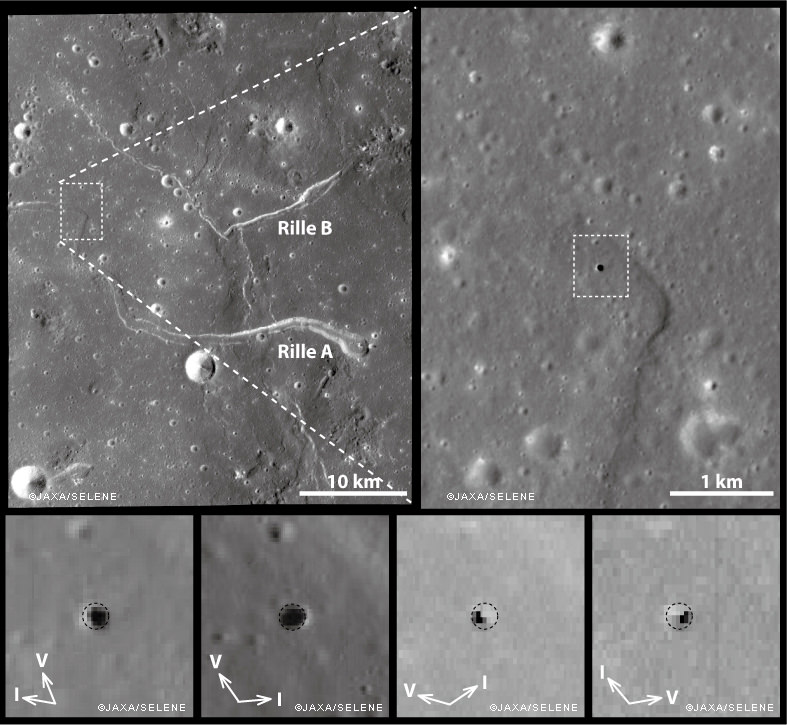Infrastructure is going to be one of the biggest components of any permanent human settlement on the moon. NASA Artemis missions are focused directly on building up the facilities and processes necessary to support a moon base. ESA is also contributing both material and knowledge. Most recently they made another step in their path to explore some lava tubes and caves in the subterranean lunar world.
Continue reading “ESA is Working on a Mission to Explore Caves on the Moon”Lava Tubes on the Moon and Mars are Really, Really Big. Big Enough to Fit an Entire Planetary Base
Could lava tubes on the Moon and Mars play a role in establishing a human presence on those worlds? Possibly, according to a team of researchers. Their new study shows that lunar and Martian lava tubes might be enormous, and easily large enough to accommodate a base.
Continue reading “Lava Tubes on the Moon and Mars are Really, Really Big. Big Enough to Fit an Entire Planetary Base”Why Lava Tubes Should be Our Top Exploration Priority on Other Worlds

When magma comes out of the Earth onto the surface, it flows as lava. Those lava flows are fascinating to watch, and they leave behind some unique landforms and rocks. But a lot of what’s fascinating about these flows can be hidden underground, as lava tubes.
These lava tubes are turning out to be a very desirable target for exploration on other worlds, just as they are here on Earth.
Continue reading “Why Lava Tubes Should be Our Top Exploration Priority on Other Worlds”Lava Tube Openings Found Near the Moon’s North Pole
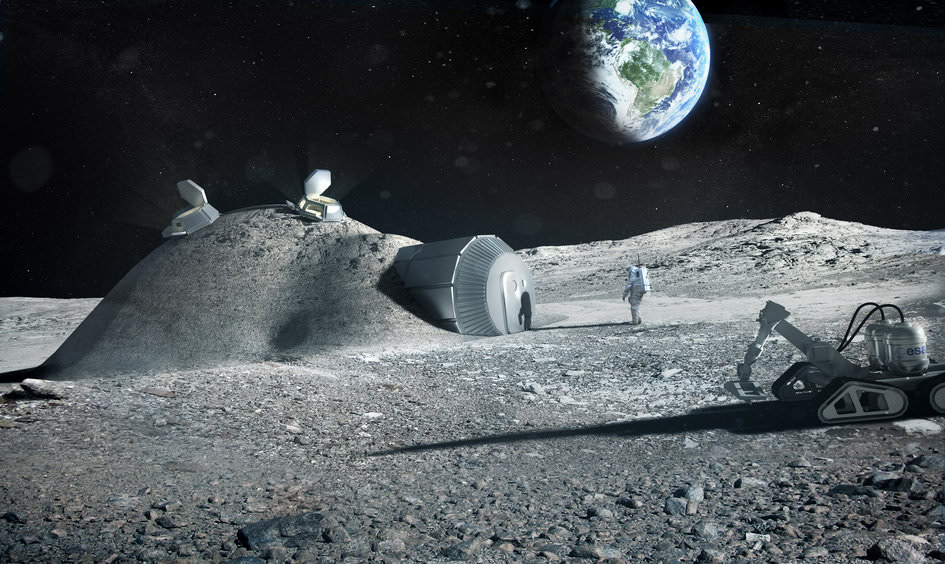
Between NASA, the Chinese National Space Agency, the European Space Agency and Roscosmos, there’s no shortage of plans for returning to the Moon and creating a permanent base there. Naturally, these plans have given rise to questions of where such bases should be built. So far, the top contenders have been lava tubes that have been spotted in various locations across the surface of the Moon and in the polar regions.
Whereas the polar regions are permanently shaded and appear to have abundant ice water, stable lava tubes would offer protection against the elements and harmful radiation. However, according to a new discovery presented at NASA’s Lunar Science for Landed Missions Workshop, it appears that there is a location on the Moon that ticks off both boxes – a possible lava tube that is located in the norther polar region!
This discovery was detailed in an abstract titled “Philolaus Crater: Exploring Candidate Lava Tubes And Skylights Near The Lunar North Pole“. The author was Pascal Lee, the co-founder and chairman of the Mars Institute, a planetary scientist at the SETI Institute, and the Principal Investigator of the Haughton-Mars Project (HMP) at NASA’s Ames Research Center.
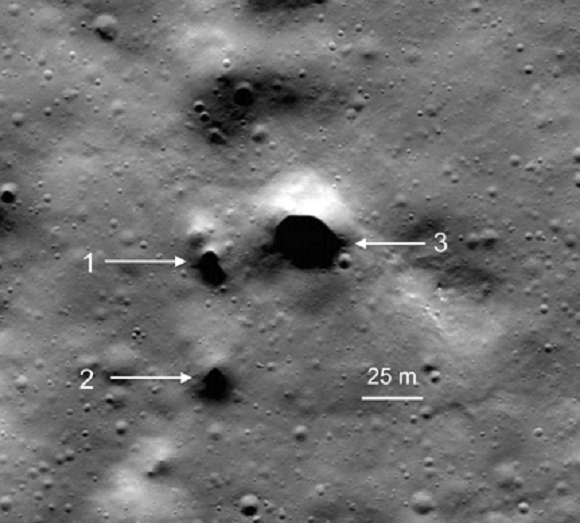
These pits were identified based on an analysis of imaging data from NASA’s Lunar Reconnaissance Orbiter (LRO). These images indicated the presence of small pits in the northeastern floor of the Philolaus Crater, a 70 km (43 mi)-diameter impact crater located about 550 km (340 mi) from the Moon’s North Pole. These pits could potentially be “skylights”, holes in the surface that lead to subterranean recesses.
Each pit appears to be a rimless depression measuring roughly 15 to 30 meters (50 to 11 ft) across and have shadowed interiors. Moreover, the pits are located along winding channels known as “sinous rilles” that are present along the floor of the Philolaus Crater. On the moon, these channels are thought to be the result of subterranean lava tubes that have since collapsed, or partially collapsed.
If water ice is present in the region, then these skylights could allow future explorers access to subsurface water ice that is less tainted by regolith. This presents a number of opportunities for research, and future long-term missions to the lunar surface. As Pascal Lee explained:
“The highest resolution images available for Philolaus Crater do not allow the pits to be identified as lava tube skylights with 100 percent certainty, but we are looking at good candidates considering simultaneously their size, shape, lighting conditions and geologic setting.”
In recent years, over 200 pits have been discovered by other researchers on the Moon, many of which were identified as possible skylights leading to underground lava tubes. However, this latest discovery is the first to place a possible skylight and lava tube within the Moon’s polar regions. These regions have become the focal point of research in recent years due to the fact that water ice is known to exist in the polar regions.
Within these permanently-shadowed cratered regions – particularly the South Pole-Aitken Basin – water ice is known to exist within the regolith. As a result, multiple proposals have been made to create lunar bases in the polar regions. However, there remains the challenge of how to get to that water (which would require drilling) and the fact that a permanently-shadowed region would not allow access to solar power.
This new discovery is therefore exciting for three reasons. For one, it would allow for much easier access to lunar polar ice that would be much more pure than anything drilled from the surface. Second, solar power would be available nearby, just outside each skylight. And third, these openings could provide access to a stable lava tube that contains water ice itself, much as lava tubes on Earth do.
Philolaus Crater also offers two additional bonuses when it comes a lunar settlement. Given that the crater formed in the Copernican Era (i.e. the last 1.1 billion years) it is relatively young as lunar craters go. As such, it would offer scientists with plenty of opportunities to study the Moon’s more recent geological history. Also, since the Philolaus Crater is on the near-side on the Moon, it would allow direct communications with Earth.
And as Lee added, a base in this location would also allow for some amazing views:
“We would also have a beautiful view of Earth. The Apollo landing sites were all near the Moon’s equator, such that the Earth was almost directly overhead for the astronauts. But from the Philolaus skylights, Earth would loom just over the crater’s mountainous rim, near the horizon to the southeast.”
Looking ahead, Lee and his colleagues indicate that further exploration is needed to verify whether or not these pits are lava tube skylights and whether or not they contain ice. In the future, astronauts and robots could be sent to the polar regions of the Moon in order to seek out and explore caves that have been identified from orbit. As Lee explained, this will have benefits that go far beyond lunar exploration.
“Exploring lava tubes on the Moon will also prepare us for the exploration of lava tubes on Mars,” he said. “There, we will face the prospect of expanding our search for life into the deeper underground of Mars where we might find environments that are warmer, wetter, and more sheltered than at the surface.”
And as Bill Diamond – president and CEO of the SETI Institute – explained, this discovery highlights the true nature of exploration, which goes well beyond orbiters and robotic explorers:
“This discovery is exciting and timely as we prepare to return to the Moon with humans. It also reminds us that our exploration of planetary worlds is not limited to their surface, and must extend into their mysterious interiors”.
The Lunar Science for Landed Missions Workshop was convened by the Solar System Exploration Research Virtual Institute (SSERVI) at NASA’s Ames Research Center. The purpose of the workshop was to examine the range of scientific investigations that could be conducted on the Moon, including in-situ science, network science and sample return missions.
Further Reading: SETI
Stable Lava Tube Could Provide a Potential Human Habitat on the Moon
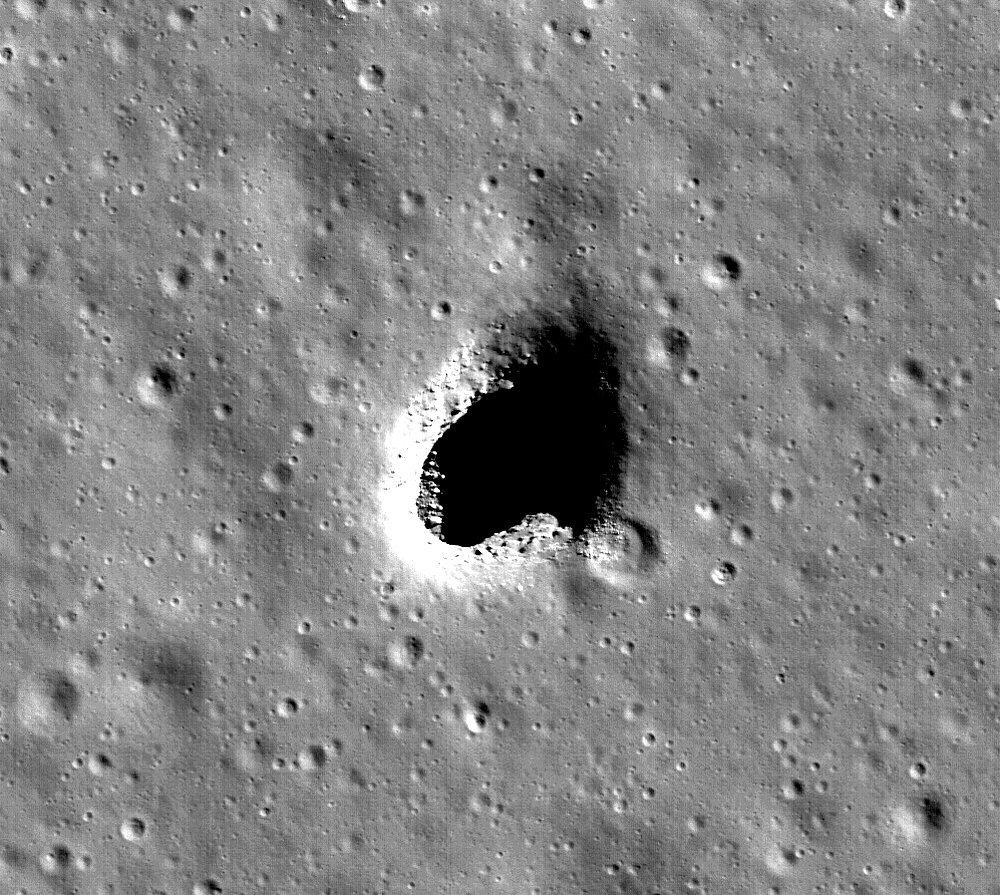
On October 5th, 2017, Vice President Mike Pence announced the Trump administration’s plan to return astronauts to the Moon. Looking to the long-term, NASA and several other space agencies are also intent on establishing a permanent lunar base there. This base will not only provide opportunities for lunar science, but will facilitate missions to Mars and beyond.
The only question is, where should such a base be built? For many years, NASA, the ESA and other agencies have been exploring the possibility of stable lava tubes as a potential site. According to new study by a team of international scientists, the presence of such a tube has now been confirmed in the Marius Hills region. This location is likely to be the site of future lunar missions, and could even be the site of a future lunar habitat.
In 2009, data provided by the Terrain Camera aboard JAXA’s SELENE spacecraft indicated the presence of three huge pits on the Moon. These pits (aka. “skylights”) were of particular interest since they were seen as possible openings to subsurface lava channels. Since then, the Marius Hills region (where they were found) has been a focal point for astronomers and planetary scientists hoping to confirm the existence of lava tubes.
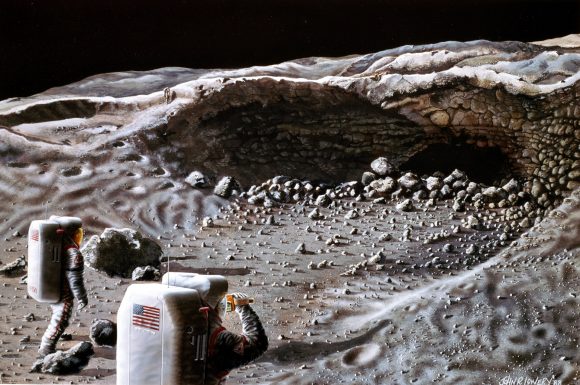
The recent study, titled “Detection of intact lava tubes at Marius Hills on the Moon by SELENE (Kaguya) Lunar Radar Sounder“, recently appeared in the journal Geophysical Research Letters. The team consisted of members from JAXA’s Institute of Space and Astronautical Science (ISAS), Purdue University, the University of Alabama, AstroLabs, the National Astronomical Observatory of Japan (NOAJ) and multiple Japanese Universities.
Together, they examined data from the SELENE mission’s Lunar Radar Sounder (LRS) from locations that were close to the Marius Hills Hole (MHH) to determine if the region hosted stable lava tubes. Such tubes are a remnant from the Moon’s past, when it was still volcanically active. These underground channels are believed to be an ideal location for a lunar colony, and for several reasons.
For starters, their thick roofs would provide natural shielding from solar radiation, cosmic rays, meteoric impacts, and the Moon’s extremes in temperature. These tubes, once enclosed, could also be pressurized to create a breathable environment. As such, finding an entrance to a stable lava tube would the first step towards selecting a possible site for such a colony.
As Junichi Haruyama, a senior researcher at JAXA and one of the co-authors on the study, explained in a University of Purdue press release:
“It’s important to know where and how big lunar lava tubes are if we’re ever going to construct a lunar base. But knowing these things is also important for basic science. We might get new types of rock samples, heat flow data and lunar quake observation data.”

Granted, the LRS was not specifically designed to detect lava tubes, but to characterize the origins of the Moon and its geologic evolution. For this reason, it did not fly close enough to the Moon to obtain extremely accurate information on the subsurface. Nevertheless, as SELENE passed near the Marius Hills Hole, the instrument picked up a distinctive echo pattern.
This pattern was characterized by a decrease in echo power followed by a large second echo peak. These two echoes correspond to radar reflections from the Moon’s surface, as well as the floor and ceiling of the open lava tube. When they analyzed this pattern, the research team interpreted it is evidence of a tube. They found similar echo patterns at several locations around the hole, which could indicate that there is more than one lava tube in the region.
To confirm their findings, the team also consulted data from NASA’s Gravity Recovery and Interior Laboratory (GRAIL) mission. Consisting of two spacecraft, this collaborative effort collected high-quality data on the Moon’s gravitational field between 2011 and 2012. By using GRAIL data that identified mass deficits under the surface, which are evidence of caverns, the team was able to narrow down their search.
Jay Melosh, a GRAIL co-investigator and Distinguished Professor of Earth, Atmospheric and Planetary Sciences at Purdue University, was also a co-author on the paper. As he explained:
“They knew about the skylight in the Marius Hills, but they didn’t have any idea how far that underground cavity might have gone. Our group at Purdue used the gravity data over that area to infer that the opening was part of a larger system. By using this complimentary technique of radar, they were able to figure out how deep and high the cavities are.”
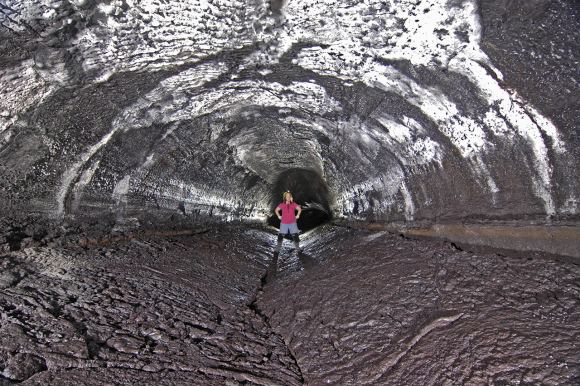
On Earth, stable lava tubes have been found that can extend for dozens of kilometers. To date, the longest and deepest to be discovered is the Kazumura Cave in Hawaii, which is over a kilometer (3,614 feet) deep and 65.5 km (40.7 mi) long. On the Moon, however, lava tubes are much larger, due to the fact that the Moon has only a fraction of the Earth’s gravity (0.1654 g to be exact).
For a lava tube to be detecting using gravity data, it would need to be several kilometers in length and at least one kilometer in height and width. Since the tube in Marius Hills was detectable, it is likely big enough to house a major city. In fact, during a presentation at the 47th Lunar and Planetary Conference, researchers from Purdue University showed GRAIL data that indicated how the tube beneath the MHH could be large enough to house Philadelphia.
This most recent study was also the subject of a presentation at the 48th Lunar and Planetary Conference. Similar evidence of possible stable lava tubes in the Sea of Tranquility was also obtained by the Lunar Reconnaissance Orbiter (LRO) back in 2010. However, this latest combination of radar and gravity data has provided the clearest picture yet of what a stable lava tube looks like.
Similar evidence of lava tubes has also been discovered on Mars, and possible even Mercury. On Mars in particular, chains of pit craters, broad lava fans, skylights and partially collapsed lava tubes all indicate the presence of stable tubes. Based on this latest study, future mission to the Red Planet (which could include the creation of a habitat) might also entail the investigation of these features.
In fact, lava tubes could become the means through which a human presence is established throughout the Solar System someday!
Further Reading: Purdue University, Geophysical Research Letters
How Do We Terraform Mercury?
Welcome back to another installment in the “Definitive Guide to Terraforming” series! We complete our tour of the Solar System with the planet Mercury. Someday, humans could make a home on this hostile planet, leading to the first Hermians!
The planet Mercury is an intensely hot place. As the nearest planet to our Sun, surface temperatures can get up to a scorching 700 K (427° C). Ah, but there’s a flip-side to that coin. Due to it having no atmosphere to speak of, Mercury only experiences intensely hot conditions on the side that is directly facing the Sun. On the nighttime side, temperatures drop to well below freezing, as low as 100 K (-173° C).
Due to its low orbital period and slow rate of rotation, the nighttime side remains in the dark for an extended period of time. What’s more, in the northern polar region, which is permanently shaded, conditions are cold enough that water is able to exist there in ice form. Because of this, and a few reasons besides, there are many who believe that humanity could colonize and even terraform parts of Mercury someday.
GRAIL Data Points To Possible Lava Tubes On The Moon
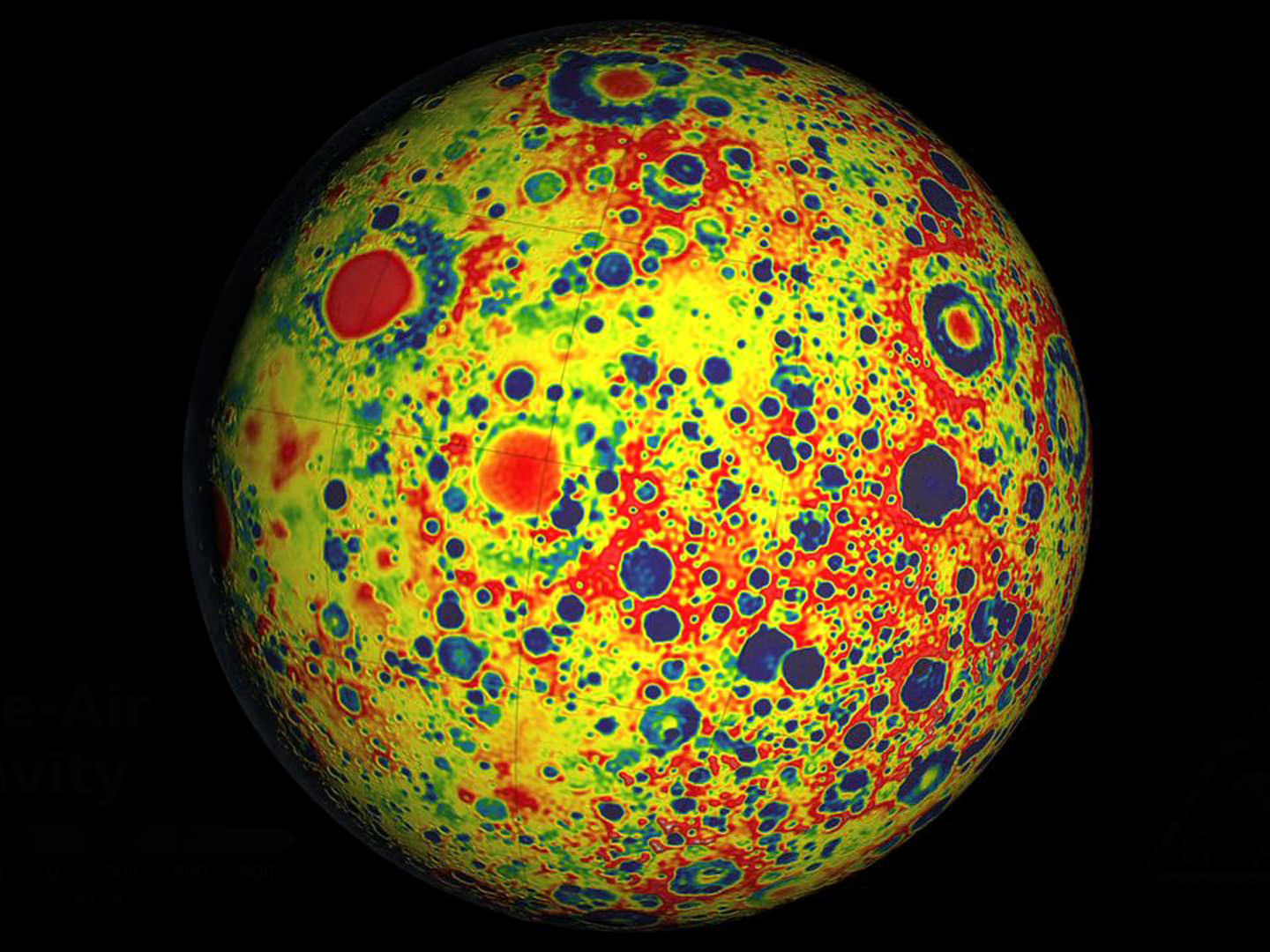
For years, scientists have been hunting for the stable lava tubes that are believed to exist on the Moon. A remnant from the Moon’s past, when it was still volcanically active, these underground channels could very well be an ideal location for lunar colonies someday. Not only would their thick roofs provide naturally shielding from solar radiation, meteoric impacts, and extremes in temperature. They could also be pressurized to create a breathable environment.
But until now, evidence of their existence has been inferred from surface features such as sinuous rilles – channel-like depressions that run along the surface that indicate the presence of subterranean lava flows – and holes in the surface (aka. “skylights”). However, recent evidence presented at the 47th Lunar and Planetary Science Conference (LPSC) in Texas indicates that one such stable lava tube could exist in the once-active region known as Marius Hills.
Continue reading “GRAIL Data Points To Possible Lava Tubes On The Moon”
How Do We Terraform The Moon?

Welcome back to our ongoing series, “The Definitive Guide To Terraforming”! We continue with a look at the Moon, discussing how it could one day be made suitable for human habitation.
Ever since the beginning of the Space Age, scientists and futurists have explored the idea of transforming other worlds to meet human needs. Known as terraforming, this process calls for the use of environmental engineering techniques to alter a planet or moon’s temperature, atmosphere, topography or ecology (or all of the above) in order to make it more “Earth-like”. As Earth’s closest celestial body, the Moon has long been considered a potential site.
All told, colonizing and/or terraforming the Moon would be comparatively easy compared to other bodies. Due to its proximity, the time it would take to transport people and equipment to and from the surface would be significantly reduced, as would the costs of doing so. In addition, it’s proximity means that extracted resources and products manufactured on the Moon could be shuttled to Earth in much less time, and a tourist industry would also be feasible.
Continue reading “How Do We Terraform The Moon?”There Could Be Lava Tubes on the Moon, Large Enough for Whole Cities
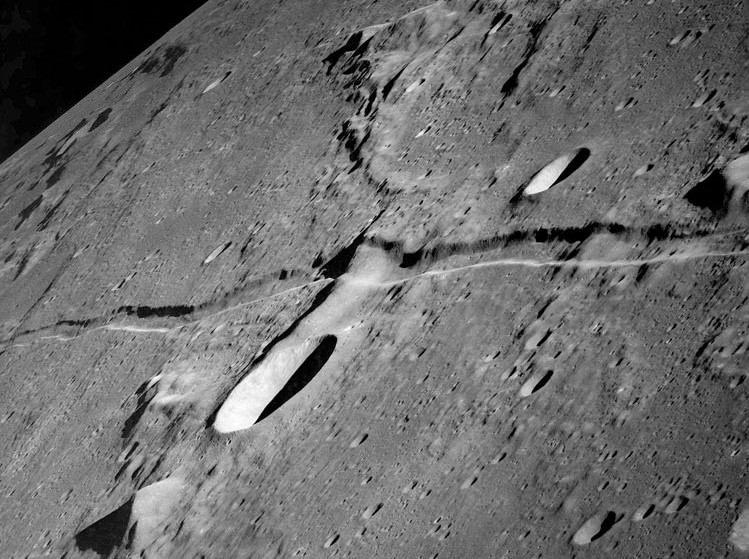
Every year since 1970, astronomers, geologists, geophysicists, and a host of other specialists have come together to participate in the Lunar and Planetary Science Conference (LPCS). Jointly sponsored by the Lunar and Planetary Institute (LPI) and NASA’s Johnson Space Center (JSC), this annual event is a chance for scientists from all around the world to share and present the latest planetary research concerning Earth’s only moon.
This year, one of the biggest attention-grabbers was the findings presented on Tuesday, March 17th by a team of students from Purdue University. Led by a graduate student from the university’s Department of Earth, Atmospheric and Planetary Sciences, the study they shared indicates that there may be stable lava tubes on the moon, ones large enough to house entire cities.
In addition to being a target for future geological and geophysical studies, the existence of these tubes could also be a boon for future human space exploration. Basically, they argued, such large, stable underground tunnels could provide a home for human settlements, shielding them from harmful cosmic radiation and extremes in temperature.
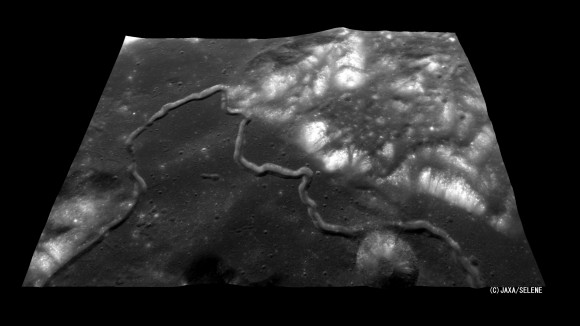
Lava tubes are natural conduits formed by flowing lava that is moving beneath the surface as a result of a volcanic eruption. As the lava moves, the outer edges of it cools, forming a hardened, channel-like crust which is left behind once the lava flow stops. For some time, Lunar scientists have been speculating as to whether or not lava flows happen on the Moon, as evidenced by the presence of sinuous rilles on the surface.
Sinuous rilles are narrow depressions in the lunar surface that resemble channels, and have a curved paths that meanders across the landscape like a river valley. It is currently believed that these rilles are the remains of collapsed lava tubes or extinct lava flows, which is backed up by the fact they usually begin at the site of an extinct volcano.
Those that have been observed on the Moon in the past range in size of up to 10 kilometers in width and hundreds of kilometers in length. At that size, the existence of a stable tube – i.e. one which had not collapsed to form a sinuous rille – would be large enough to accommodate a major city.
For the sake of their study, the Purdue team explored whether lava tubes of the same scale could exist underground. What they found was that the stability of a lava tube depended on a number of variables- including width, roof thickness and the stress state of the cooled lava. he researchers also modeled lava tubes with walls created by lava placed in one thick layer and with lava placed in many thin layers.

David Blair, a graduate student in Purdue’s Department of Earth, Atmospheric and Planetary Sciences, led the study that examined whether empty lava tubes more than 1 kilometer wide could remain structurally stable on the moon.
“Our work is somewhat unique in that we’ve combined the talents of people from various Departments at Purdue,” Blair told Universe Today via email. “With guidance from Prof. Bobet (a civil engineering professor) we’ve been able to incorporate a modern understanding of rock mechanics into our computer models of lava tubes to see how they might actually fail and break under lunar gravity.”
For the sake of their research, the team constructed a number of models of lava tubes of different sizes and with different roof thicknesses to test for stability. This consisted of them checking each model to see if it predicted failure anywhere in the lava tube’s roof.
“What we found was surprising,” Blair continued, “in that much larger lava tubes are theoretically possible than what was previously thought. Even with a roof only a few meters thick, lava tubes a kilometer wide may be able to stay standing. The reason why, though, is a little less surprising. The last work we could find on the subject is from the Apollo era, and used a much simpler approximation of lava tube shape – a flat beam for a roof.
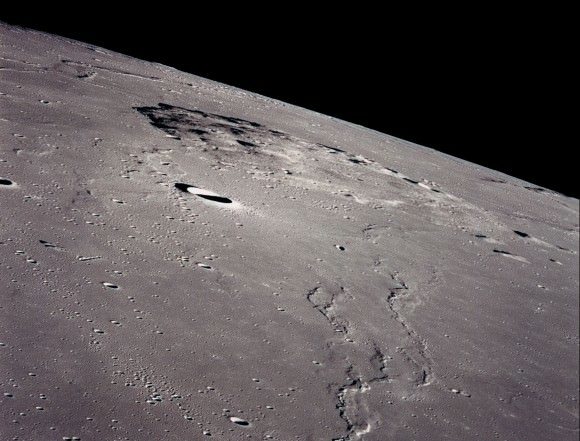
The study he refers to, “On the origin of lunar sinuous rilles“, was published in 1969 in the journal Modern Geology. In it, professors Greeley, Oberbeck and Quaide advanced the argument that sinuous rilles formation was tied to the collapse of lava flow tubes, and that stable ones might still exist. Calculating for a flat-beam roof, their work found a maximum lava tube size of just under 400 m.
“Our models use a geometry more similar to what’s seen in lava tubes on Earth,” Blair said, “a sort of half-elliptical shape with an arched roof. The fact that an arched roof lets a larger lava tube stay standing makes sense: humans have known since antiquity that arched roofs allow tunnels or bridges to stay standing with wider spans.”
The Purdue study also builds on previous studies conducted by JAXA and NASA where images of “skylights” on the Moon – i.e. holes in the lunar surface – confirmed the presence of caverns at least a few tens of meters across. The data from NASA’s lunar Gravity Recovery And Interior Laboratory (GRAIL) – which showed big variations in the thickness of the Moon’s crust is still being interpreted, but could also be an indication of large subsurface recesses.
As a result, Blair is confident that their work opens up new and feasible explanations for many different types of observations that have been made before. Previously, it was unfathomable that large, stable caverns could exist on the Moon. But thanks to his team’s theoretical study, it is now known that under the proper conditions, it is least possible.
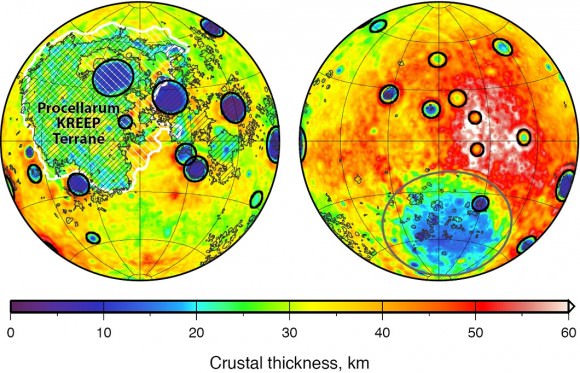
Another exciting aspect that this work is the implications it offers for future exploration and even colonization on the Moon. Already, the issue of protection against radiation is a big one. Given that the Moon has no atmosphere, colonists and agricultural operations will have no natural shielding from cosmic rays.
“Geologically stable lava tubes would absolutely be a boon to human space exploration,” Blair commented. “A cavern like that could be a really ideal place for building a lunar base, and generally for supporting a sustained human presence on the Moon. By going below the surface even a few meters, you suddenly mitigate a lot of the problems with trying to inhabit the lunar surface.”
Basically, in addition to protecting against radiation, a subsurface base would sidestep the problems of micrometeorites and the extreme changes in temperature that are common on the lunar surface. What’s more, stable, subsurface lava tubes could also make the task of pressurizing a base for human habitation easier.
“People have studied and talked about all of these things before,” Blair added, “but our work shows that those kinds of opportunities could potentially exist – now we just have to find them. Humans have been living in caves since the beginning, and it might make sense on the Moon, too!”
In addition to Melosh, Blair and Bobet, team members include Loic Chappaz and Rohan Sood, graduate students in the School of Aeronautics and Astronautics; Kathleen Howell, Purdue’s Hsu Lo Professor of Aeronautical and Astronautical Engineering; Andy M. Freed, an associate professor of earth, atmospheric and planetary sciences; and Colleen Milbury, a postdoctoral research associate in the Department of Earth, Atmospheric and Planetary Sciences.
Further Reading: Purdue News


